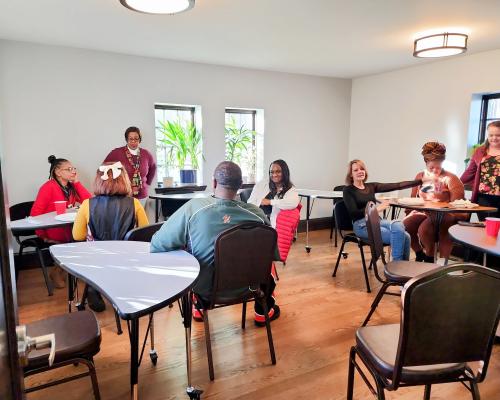
Yvonne Miller was beside herself with grief when her 23-year-old son, Christopher B Kelly, died from gun violence in August 2020. She connected with the Trauma & Resilience Initiative, a Champaign-Urbana, Illinois, mental health non-profit, and executive director Karen Crawford Simms soon showed up at her door to help her process her trauma.
Every week, Simms encouraged Miller to cherish the memories of her son and offered her a space to cry. At Simms’s suggestion, Miller kept a diary in which she documented the ebb and flow of denial and anger.
Through in-person and virtual sessions with Simms, Miller climbed her way out of the initial stages of grief. In 2023, she even created a weekly support group for mothers in the metropolitan area who have lost their children to gun violence, “because nobody knows what we’re going through”, Miller said, “except us”.
But the neighbor-to-neighbor counseling, which helped Miller cope, is no more. The non-profit’s funding from the American Rescue Plan Act (Arpa), a Biden-era stimulus bill, ran out. And the organization had to end its crisis support for gun-violence survivors in July. Before then, Simms and her team had offered a free 40-hour training program to community members in areas with gun violence, as well as to providers who work with people experiencing homelessness, formerly incarcerated people and religious congregation members. From the non-profit’s founding in 2019 until funding recently ran out, Simms and her team trained more than 500 people in Champaign-Urbana.
If the Trauma & Resilience Initiative can’t find other grants, it may close in December. Its potential closure mirrors the fate of other organizations nationwide that focus on community violence and also rely on Arpa funds that will expire by the end of 2026. And now, under the Trump administration, there are even fewer federal resources for such programs. In April, the Department of Justice’s office of justice programs canceled 373 grants totaling about $500m. Some of that amount went toward violence reduction, according to a recent report from the non-profit Council on Criminal Justice.
“Arpa was really a gamechanger for the community violence intervention and prevention field,” said Nick Wilson, senior director for gun violence prevention at the Center for American Progress, in Governing magazine. “Arpa was really a chance for cities to really experiment and scale up existing programs, and especially for a lot of places, we saw new programs being started.”
The sunset of Arpa funding and additional cuts come as gun violence killed 128 people a day in 2023 throughout the nation, according to the most recent Centers for Disease Control and Prevention data. While a decrease from the previous two years, the death toll is the third highest on record since 1968.
As the Trauma & Resilience Initiative’s board searches for grants, Simms is offering additional training to residents so that the non-profit’s work will continue to live on despite its potential closure. Simms and her mental health specialist volunteers still offer support groups for children, teens and adults to process traumatic experiences. They also provide stress management support for individuals, families and providers who work with populations facing adversity. And they train community leaders on how to support immigrants and refugees if their families are torn apart or if they fear immigration raids. Starting in the fall, they hope to offer training to organizations and survivors of community trauma, including gun violence and natural disasters – if the initiative stays open.
Simms is hopeful that the Trauma & Resilience Initiative will be saved if Congress passes a recently introduced House bill that would direct the US Department of Health and Human Services to fund community-based resilience and mental health programs.
The Trauma & Resilience Initiative seeks to offer an alternative to policing and focuses on addressing the roots of violence in the Black community, often home to “the individuals most impacted by gun violence”, Simms said. To reduce overpolicing in their neighborhoods, Simms said that responders often call organizers who focus on averting violence instead of contacting law enforcement.
“Our goal is to de-escalate things for the communities that we work with and serve,” Simms said. “From a brain perspective, law enforcement can be triggering. And so once your amygdala is activated, we think that it probably would make the situation worse, and we’d prefer to step away, or give you a minute.”
The initiative’s training aims to interrupt gun violence by helping community responders identify signs of distress and increase problem solving skills through roleplaying, visualization and writing exercises. “Particularly when we’re thinking about neighborhoods that have been impacted by structural inequality and community violence, we want to make sure that there are feelings of safety,” Simms said, “that you’re from the neighborhood, you are trusted by the neighborhood.”
Simms’s work and the city’s efforts to prevent and intervene in gun violence may have helped reduce shootings in Champaign in recent years. The number of deaths by gunfire declined by more than 68% between 2021 and 2024, from 16 to five, respectively, according to Champaign police department data reported by WCIA.
“We want to improve our community’s capacity to take care of its own,” Simms said. “We want it to democratize health and healing, so that the community has the tools, and we don’t have to professionalize trauma healing.”
‘There is a future’
Even before Arpa funding encouraged city leaders throughout the nation to launch violence prevention programs after the Covid-19 pandemic, community members in Champaign-Urbana were focused on bringing a trauma-informed care model to the area. Trauma-informed care recognizes that violence and other adverse experiences affect people’s coping strategies and development. Taking that into account, practitioners seek to foster safety and resilience. The framework originally began in the 1960s and 1970s, and has now been adopted by cities, businesses and schools throughout the nation.
The model came to Champaign-Urbana by way of tragedy. When 15-year-old Kiwane Carrington was shot and killed by Champaign police in 2009, community members resolved to address violence by tackling trauma. That eventually led Champaign county’s mental health board to fund a community group that trained residents to provide neighbor-to-neighbor counseling.
The community group then convinced Simms to found the Trauma & Resilience Initiative in 2019. In recent years, most of the non-profit’s funding – $900,000 – came from Arpa funds, which allowed the organization to pay for Black therapists to receive trauma-informed certifications. “If we’re going to change the infrastructure,” Simms said, “we have to change the workforce.”
Over the years, the initiative’s free programming grew from providing grief support for families who experienced gun violence to offering wraparound services by connecting clients with organizations that helped them find housing, jobs and healthcare.
Before funds dried up, organizations such as homeless shelters, refugee resettlement offices, re-entry programs and law enforcement agencies gave the non-profit’s phone number to residents in need of help, Simms said, and about a quarter of references came from word of mouth. Paid mental health providers were available to answer calls 24/7. Since they’re from a smaller community, responders sometimes drove to a person’s location to talk to them face to face. “Rather than having to wait until a therapist appointment, you can have somebody who can meet with the people in their homes, at McDonald’s, at the library – wherever makes sense,” Simms said. “People pull over and sit in their car and talk, and my team is there for you when you need them, texting you tools, reminding you of those tools.”
Earlier this year, hospital staff called the hotline when a patient was discharged and was unable to return to their home due to tension in the household. So the Trauma & Resilience Initiative called upon trained volunteers to meet with the person in the non-profit’s office, where they also supplied food. The volunteers helped de-escalate the situation by calming the person down and collaborating with another local organization to provide the person with a hotel room. “That’s the beautiful thing about having a community-based approach, is we can be pretty flexible,” Simms said. “And we see ourselves as a part of a team, a network of people in the community.”
James Corbin works as a peer mentor and drop-in center coordinator at the non-profit FirstFollowers, which helps formerly incarcerated people find work and housing. Corbin has attended several training sessions from the Trauma & Resilience Initiative, which he said that he’s used to help hundreds of people in various situations. Through the training, he learned how to identify when someone is in a trauma response. He established trust with the population that he served by sharing his own experience of being incarcerated and becoming paralyzed from gun violence.
Three years ago, he responded to a call from a formerly incarcerated person who was also in a wheelchair and was considering hurting himself. Corbin talked the man down by sharing his personal story and reminding him what made his life worth living. “I got into his head, into his mind, and I understand where he’s at. He’s at a high anxiety level. He don’t see a future,” Corbin said. “Part of that training is: ‘There is a future. You can do this.’”
If the Trauma & Resilience Initiative can raise money, Simms hopes to offer stipends and additional training to volunteers so neighbor-to-neighbor counseling can continue regardless of the organization’s future.





